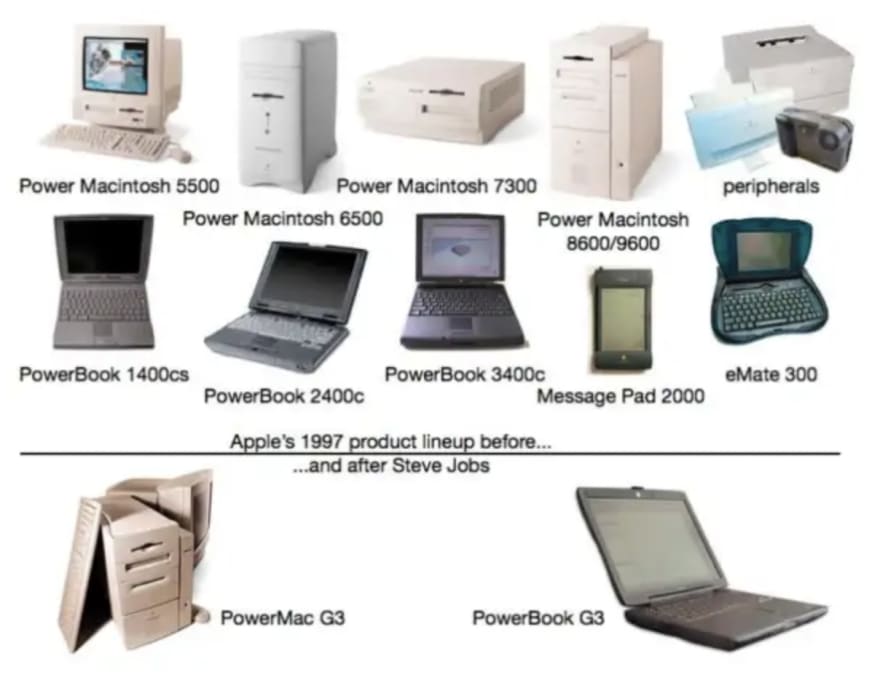The race to implement an enterprise digital transformation is relentless and moving faster than ever. Reading MIT Sloan – “Your business is too complex to be Digital” really struck me. Time and again organisations are struggling with weak branding, poor vision or resource debt from previous business decisions.
As leaders, do we have the courage to stop and reflect on our enterprise digital transformation? The pandemic has allowed people to declutter – their bookshelves, their wardrobes, their sheds, their digital subscriptions, their lives. Are we starting to observe the great declutter of business? Who will emerge as the Marie Kondo of business in the 2020s? Are we to see a Konmari method of ruthless prioritisation? Start-ups already do it – they must to survive, but what about large organisations?
Apple are declutter experts
I am no Apple buff, but one story that comes up over and over is the impact Steve Jobs had at Apple. With the introduction of the Mac in the 1980s, Apple mastered innovation through bringing a new product to market that created fantastic customer experience. Jobs departed from Apple to seek out other ventures. As the story goes, by 1997, Apple had over-extended and was not in good shape. The company was two quarters away from going bust when Jobs came back. He famously said a relative asked him which Apple computer to buy for their family home. Jobs looked at the product range and eventually came back and said, “I don’t know; it’s too confusing”. The first thing he did was ruthlessly prioritise. He stopped everything that was not at the core business of making a computer to change the world — he simplified the software, supply chain and distribution, as well as the peripherals, models and products on offer.
He also fixed the naming of products. From “the Apple Quadra 660av” to “the new Mac” – Apple still use this convention today. They will use model numbers internally (the 2016 MacBook), but to the customer, its two computers – the new mac and the new MacBook. There are customizations in screen sizes, memory and speed – but these are downplayed. As you can see, Apple’s share price has responded well to this vision of FIRE – Fast, Inexpensive, Restrained and Elegant (Dan Ward).
The importance of technology in the C-suite
The immediate response to the Steve Jobs story is usually “that’s ok, but not everyone is Steve Jobs”. I think that’s missing the point. What he did was Enterprise Digital Transformation 101 – it had nothing to do with technology. He started with ruthless simplification. This is a pattern that has been repeated. We can look for similar examples at Amazon, Spotify, Netflix, Tesla and Airbnb. There is an unrelenting focus – technology comes later.
Another fascinating article in MIT Sloan is: “Does your C-Suite have enough Digital smarts?” The article reveals that ‘digital smarts’ in the team that sets the enterprise digital transformation is in low supply. For me, part of having ‘digital smarts’ (I don’t like the term, but let’s not start) is the ability to know what to ask for, how to ask for it and knowing when to say no, in other words craft your enterprise digital transformation.
Let’s break that down — the C-Suite need to be crystal clear on the organisation’s goal and mission. Enterprise Digital Transformation must enable that goal and anything that doesn’t needs to be questioned. Don’t ask for technology; ask for capability. “Can we reduce our operational IT costs and increase our time to market using Public Cloud” is better than “Can we go to the Cloud?”
If someone is making a tech pitch that sounds like: “AI will change the world, we need to explore it”, you need to push back and be clear on the ‘why’ and the ‘what’. Resume-Driven Development is a real phenomenon, and I am no longer surprised when I hear about millions spent to boost someone’s resume at the company’s expense.
Educate to deliver your enterprise digital transformation
With a mission of ruthless simplification and an educated C-suite, companies can start to achieve. A Serverless-First approach can achieve great things. We have agreed to declutter; we have a clear business goal – we can now stop focusing on things that are not core to our business and focus on real business differentiators.
Amazon have a term for this called “Single Threaded Leadership”. I have seen this in action, and it is liberating. The goals of technology and business are the same – let’s delight our customer. The friction starts when overbearing management structures get in the way and slow things down. All that is needed is ownership and accountability – just point me at a problem and let me go. If I need support, I’ll tell you.
Take the time to make sure a North Star is in place, then ruthlessly declutter everything else. If an organisation has a vague or complex North Star, this is a signal for the executive team to take action.
Inertia eats enterprise digital transformation
Organisations can perceive many obstacles:
- Technical Debt – “we have decades of old systems”.
- Operational complexity – “we are fire-fighting all the time”.
- Poor leadership – “we don’t have the drive we need”.
- Customer Demands – “the market is very demanding”.
- Staff issues – “we don’t have the people”.
- Burn rate – “we are running too hot.”
If organisations want to “go digital”, then courage is required to pick a path, take action and execute. Steve Jobs legacy of those values has led to Apple’s continuing achievements:
At $2 trillion, Apple’s market value is now higher than the GDP of numerous developed countries, including Italy, Brazil, Canada, Russia and South Korea, to name a few.
– Forbes







Top comments (0)